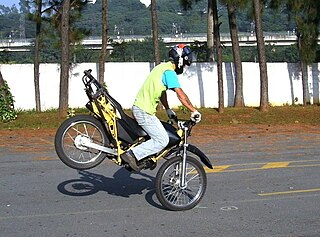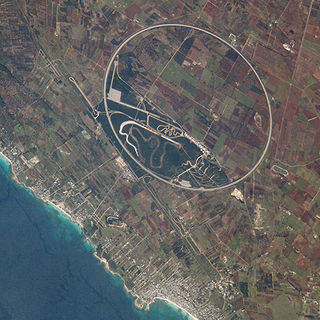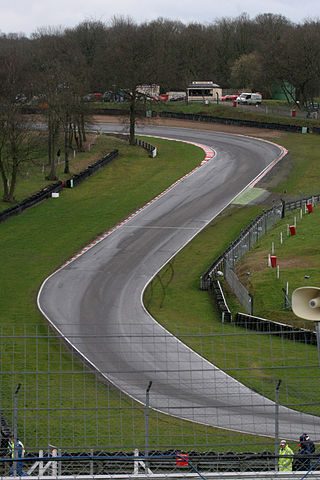Vehicle dynamics is the study of vehicle motion, e.g., how a vehicle's forward movement changes in response to driver inputs, propulsion system outputs, ambient conditions, air/surface/water conditions, etc. Vehicle dynamics is a part of engineering primarily based on classical mechanics. It may be applied for motorized vehicles, bicycles and motorcycles, aircraft, and watercraft.

The Porsche 959 is a sports car manufactured by German automobile manufacturer Porsche from 1986 to 1993, first as a Group B rally car and later as a road legal production car designed to satisfy FIA homologation regulations requiring at least 200 units be produced.
Understeer and oversteer are vehicle dynamics terms used to describe the sensitivity of the vehicle to changes in steering angle associated with changes in lateral acceleration. This sensitivity is defined for a level road for a given steady state operating condition by the Society of Automotive Engineers (SAE) in document J670 and by the International Organization for Standardization (ISO) in document 8855. Whether the vehicle is understeer or oversteer depends on the rate of change of the understeer angle. The Understeer Angle is the amount of additional steering that must be added in any given steady-state maneuver beyond the Ackermann steer angle. The Ackermann Steer Angle is the steer angle at which the vehicle would travel about a curve when there is no lateral acceleration required.
Automobile handling and vehicle handling are descriptions of the way a wheeled vehicle responds and reacts to the inputs of a driver, as well as how it moves along a track or road. It is commonly judged by how a vehicle performs particularly during cornering, acceleration, and braking as well as on the vehicle's directional stability when moving in steady state condition.

A highsider or high-side is a type of motorcycle accident characterized by sudden and violent rotation of the bike around its longitudinal axis. This generally happens when the rear wheel loses traction, skids, and then suddenly regains traction, causing the rider to be thrown head-first from the side of the motorcycle or over the handlebars.

Weight transfer and load transfer are two expressions used somewhat confusingly to describe two distinct effects:

The Nardò Ring, originally known as Pista di prova di Nardò della Fiat when it was built in 1975, is a high speed test track located at more than 23 kilometres (14 mi) north-west of the town of Nardò, Italy, in the southern region of Apulia, in the Province of Lecce. It was acquired by Porsche Engineering in 2012 from its former owners, Prototipo SpA. Porsche now calls the site Nardò Technical Center.

Trail braking is a driving and motorcycle riding technique where the brakes are used beyond the entrance to a turn (turn-in), and then gradually released. Depending on a number of factors, the driver fully releases brake pressure at any point between turn-in and the apex of the turn.
The Eötvös effect is the change in measured Earth's gravity caused by the change in centrifugal acceleration resulting from eastbound or westbound velocity. When moving eastbound, the object's angular velocity is increased, and thus the centrifugal force also increases, causing a perceived reduction in gravitational force.
Lift-off oversteer is a form of sudden oversteer. While cornering, a driver who closes the throttle, usually at a high speed, can cause such sudden deceleration that the vertical load on the tires shifts from rear to front, in a process called load transfer. This decrease in vertical load on the rear tires in turn decreases their traction by lowering their lateral force, making the vehicle steer more tightly into the turn. In other words, easing off the accelerator in a fast turn can cause a car's rear tires to loosen their grip so much that the driver loses control and drifts outwards, even leaving the road tailfirst.

In motorsport, the racing line is the optimal path around a race course. In most cases, the line makes use of the entire width of the track to lengthen the radius of a turn: entering at the outside edge, touching the "apex"—a point on the inside edge—then exiting the turn by returning outside.

Bicycle and motorcycle dynamics is the science of the motion of bicycles and motorcycles and their components, due to the forces acting on them. Dynamics falls under a branch of physics known as classical mechanics. Bike motions of interest include balancing, steering, braking, accelerating, suspension activation, and vibration. The study of these motions began in the late 19th century and continues today.

The Caterham Seven CSR is the latest model from sports car manufacturer Caterham Cars. The CSR is the most heavily modified Caterham, though it still retains the basic look of the Super Seven. The CSR has two engine options based on the same Duratec block, though modifications and power output differ. The entry level engine produces 200 bhp (149 kW), with a 0–60 mph (0–97 km/h) time of 3.7 seconds. The upgraded engine produces 260 bhp (194 kW), with a 0–60 mph (0–97 km/h) time of 3.1 seconds and a top speed of 155 mph (249 km/h).

In railway engineering, curve resistance is a part of train resistance, namely the additional rolling resistance a train must overcome when travelling on a curved section of track. Curve resistance is typically measured in per mille, with the correct physical unit being Newton per kilo-Newton (N/kN). Older texts still use the wrong unit of kilogram-force per tonne (kgf/t).
Falken is a brand of passenger car, light truck, and medium truck tires owned by the Japanese company Sumitomo Rubber Industries (SRI). It was launched in its native country of Japan in 1983, and was introduced to the North American market two years later and in Europe in 1988. Falken has now become a stand-alone brand that focuses on UHP products while utilizing professional motorsports to further develop and improve products for worldwide distribution.
An automobile skid is an automobile handling condition where one or more tires are slipping relative to the road, and the overall handling of the vehicle has been affected.

The Porsche Taycan is a battery electric luxury sports sedan and shooting brake car produced by German automobile manufacturer Porsche. The concept version of the Taycan named the Porsche Mission E, debuted at the 2015 Frankfurt Motor Show. Four years later, the production Taycan was revealed at the 2019 Frankfurt Motor Show. As Porsche's first series production electric car, it is sold in several variants at different performance levels, and may spawn further derivatives in future models. It is built on the J1 electric car platform shared with the similarly shaped Audi e-tron GT.

The Dodge Viper (ZB II) is the fourth-generation Viper sports car. Introduced at the 2007 North American International Auto Show, the car was similar to its predecessor on the exterior but had undergone notable mechanical changes.

The Formula E Gen3, also known as Spark Gen3 or simply Gen3, is an electric formula race car designed for use in the FIA Formula E Championship. The car is the successor to the SRT05e, and is constructed by Spark Racing Technology. It is used as the base car for all manufacturers and teams from the 2022–23 Formula E World Championship onwards. It is the first ever formula car with both front and rear powertrains to race internationally.












